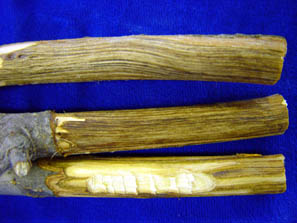DED Confirmed | |
|---|---|
| June 24, 2008 | |
|
Unfortunately, Dutch elm disease (DED) is still found on elms in Illinois. Some of the infected trees are escapes from the beetles that spread the fungus starting in the mid-1950s. Some of the newer trees may have avoided infection for other reasons. Each year at the Plant Clinic we confirm a number of cases of Dutch elm disease. In fact, we have isolated 71 cases of the Dutch elm disease fungus in the past 5 years. The first case for 2008 appeared last week. Symptoms of Dutch elm disease (DED) generally begin in early summer. Watch for yellowing of the elm leaves, followed by wilting and browning. A single branch usually shows symptoms first (called flagging), with rather rapid spread to adjacent branches and the entire tree. Look for vascular discoloration to help with diagnosis of this disease. DED causes streaking of the sapwood. You can see this streaking by peeling the bark of a symptomatic branch to reveal the brown streaks in the otherwise tan outer sapwood, as in the image.  . Verticillium wilt and Dothiorella wilt can also cause this streaking in elm. Sometimes staining from nearby cankers can be confusing as well. A similar disease caused by a phytoplasma is discussed in Report on Plant Disease (RPD), no. 660, “Elm Yellows or Phloem Necrosis and Its Control.” This is available online at http://www.ag.uiuc.edu/~vista/abstracts/a660.html. DED is caused by a fungus, Ophiostoma ulmi (Ceratocystis ulmi), which plugs up the vascular system and causes wilt and death of the tree. The Plant Clinic can test for the presence of this fungus and provides results after 7 days in the lab. American elms are very susceptible to the DED fungus. Although Chinese elm and Siberian elm are known to be more resistant, infection of these species may occur. Breeding programs have produced the more resistant Sapporo Autumn Gold, American Liberty, and Urban elms. Ask about DED resistance when purchasing elms. If you wish to use fungicides to protect nearby elms, consult the Commercial Landscape & Turfgrass Pest Management Handbook for details on chemical controls. Propiconazole and thiabendazole are active ingredients registered for preventive and therapeutic treatment of trees. For more information on DED, including management suggestions, consult Report on Plant Disease (RPD), no. 647, available online at http://www.ag.uiuc.edu/~vista/abstracts/a647.html. | |
| Author: | Nancy Pataky |
